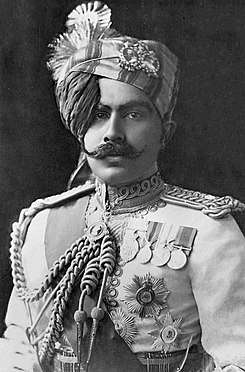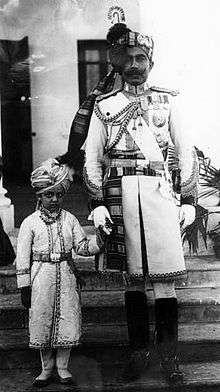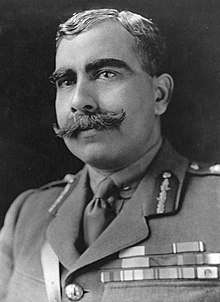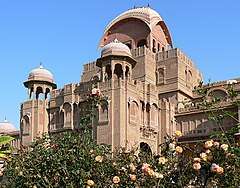Ganga Singh
| Maharaja Ganga Singh | |
|---|---|
 | |
| Maharaja of Bikaner | |
| Reign | 1888–1943 |
| Born |
3 October 1880 Bikaner, Bikaner State, British India |
| Died |
2 February 1943 (aged 62) Bombay, British India |
| Issue | Maharaja Sadul Singh |
| Father | Maharaja Lal Singh |
General Maharaja Sir Ganga Singh, GCSI, GCIE, GCVO, GBE, KCB, GCStJ (3 October 1880 – 2 February 1943), was the ruling Maharaja of the princely state of Bikaner (in present-day Rajasthan, India) from 1888 to 1943.
He is widely remembered as a modern reformist visionary, and he was also the non-White member of the British Imperial War Cabinet during World War I.
Biography
Ganga Singh was born on 3 October 1880, the third and youngest son of Maharaja Lal Singh, and brother to Dungar Singh.
Succeeding his brother on 16 December 1888, he was initially educated privately, then at Mayo College, Ajmer from 1889 to 1894. From 1895 to 1898, he was put under the guidance of Thakur Saheb Lall Singh Ji "Churu" for administrative training, learning administrative work from that of Patwari to that of Prime Minister.

For military training, he was sent to Deoli in 1898 and attached to the 42nd Deoli Regiment, which had the reputation of being one of the finest regiments in India under the command of Lt. Col. Bell. He served in China during the Boxer Rebellion (1900). During the first World War, he commanded the Bikaner Camel Corps which served in France, Egypt and Palestine.[1]
As a ruler, he established a Chief Court in Bikaner, presided over by a Chief Judge who was assisted by two judges. Bikaner was the first State in Rajasthan to take such a step. He announced the establishment of a Representative Assembly in 1913. He later established a High Court with a Chief Justice and two sub-judges by an edict in 1922. Maharaja Ganga Singhji was the first prince in Rajputana to grant full charter of powers to a high court.
A life insurance and Endowment Assurance Scheme was introduced for the benefit of the employees. Also, facilities of a saving bank were made available to the people. He was one of the first rulers to introduce through legislation a Sharda Act by which child marriages were stopped.
He had a personal gun salute of 17-guns granted in 1918 and a permanent local gun salute of 19-guns granted in 1921. He was an Honorary ADC to HRH the Prince of Wales when he visited the United Kingdom for the Coronation in 1902,[2] later serving him when he became His Majesty King George V, the King-Emperor, in 1910. A Member of the Central Recruiting Board-India 1917, he represented India at the Imperial War Conference 1917, the Imperial War Cabinet and the Paris Peace Conference 1919 and was Chancellor of the Indian Chamber of Princes from 1920–26. He also represented India as a delegate at the fifth session of the League of Nations in 1924.[3]

As well, the Maharaja served as Patron of Benares Hindu University and Sri Bharat Dharam Mahamandal, as Vice-President of East India Association and the Royal Colonial Institute, a Member of the Indian Gymkhana Club and of the Indian Army Temperance Association, the General Council of Mayo and Daly Colleges, the Indian Society of Oriental Art, the Indian Society-London, the Bombay Natural History Society, and was the first Member of the Indian Red Cross Society. Singh was a famous Indian freemason in his time.
He was also the third Chairman of the Indian Public Schools Society (The Doon School) from 1929 to 1930.
Family
He married 1stly in July 1897 HH Maharani Vallabhkuver Sahiba of Pratapgarh; she died 19 August 1906. He then married 3rdly HH Maharani Sri Bhatiyaniji Sahiba of Bikamkor and had issue, four sons and two daughters. He died 2 February 1943 in Bombay after a reign of 56 years, aged 62, and was succeeded by his son Sadul Singh
Achievements

- Singh constructed the Gang Canal. He inspired people to come and settle in this new Command area. A large population settled there from the surrounding areas of Punjab. Among them the Sikh families mostly land owners, migrated to this region in the 1920s, when the canal was built by Maharaja Ganga Singh of the former Bikaner state bringing waters of the Satluj river from the adjoining Ferozepur District in Punjab. There were no permanent settlements in this area (except for a few towns under the old Bikaner state).
- He successfully dealt with the worst famine of the year 1899–1900 AD in the region. This famine inspired the young Maharaja to establish an irrigation system to get rid of the problem permanently.
- He developed the city of Sri Ganganagar and its surrounding area as the most fertile grain bowl of Rajasthan
- He also constructed the Lalgarh Palace at Bikaner (named in memory of his father Lall Singh) between 1902 and 1926.
- He brought railways and an electricity network to the state.
- He introduced prison reforms. Bikaner prisoners wove and crafted carpets of India that were sold in the international markets.
- He established partial internal democracy such as election to the municipalities and appointed a council of ministers to aid and advice.
- Some land reforms were also introduced.
- He induced enterprising Industrialist and agriculturists from neighbouring state for starting new ventures in his state.
- He built the existing temple above the Samadhi of Ramdev Pir at Ramdevra in year 1931.
- Founder several schools and colleges, especially of women
- He donated two ornately designed silver gates to be used as main doors of Karni Mata temple at Deshnok.
Styles
- 1880–1887: Maharaj Ganga Singh of Bikaner .
- 1887–1898: His Highness Maharajadhiraj Raj-Rajeshwar Narendra Shiromani Maharaja Shri Ganga Singh Bahadur, Maharaja of Bikaner
- 1898–1900: 2nd Lieutenant His Highness Maharajadhiraj Raj-Rajeshwar Narendra Shiromani Maharaja Shri Ganga Singh Bahadur, Maharaja of Bikaner
- 1900–1901: Major His Highness Maharajadhiraj Raj-Rajeshwar Narendra Shiromani Maharaja Shri Ganga Singh Bahadur, Maharaja of Bikaner
- 1901–1904: Major His Highness Maharajadhiraj Raj-Rajeshwar Narendra Shiromani Maharaja Sir Ganga Singh Bahadur, Maharaja of Bikaner, KCIE
- 1904–1907: Major His Highness Maharajadhiraj Raj-Rajeshwar Narendra Shiromani Maharaja Sir Ganga Singh Bahadur, Maharaja of Bikaner, KCSI, KCIE
- 1907–1909: Major His Highness Maharajadhiraj Raj-Rajeshwar Narendra Shiromani Maharaja Sir Ganga Singh Bahadur, Maharaja of Bikaner, GCIE, KCSI
- 1909–1910: Lieutenant-Colonel His Highness Maharajadhiraj Raj-Rajeshwar Narendra Shiromani Maharaja Sir Ganga Singh Bahadur, Maharaja of Bikaner, GCIE, KCSI
- 1910–1911: Colonel His Highness Maharajadhiraj Raj-Rajeshwar Narendra Shiromani Maharaja Sir Ganga Singh Bahadur, Maharaja of Bikaner, GCIE, KCSI
- 1911–1917: Colonel His Highness Maharajadhiraj Raj-Rajeshwar Narendra Shiromani Maharaja Sir Ganga Singh Bahadur, Maharaja of Bikaner, GCSI, GCIE
- 1917–1919: Major-General His Highness Maharajadhiraj Raj-Rajeshwar Narendra Shiromani Maharaja Sir Ganga Singh Bahadur, Maharaja of Bikaner, GCSI, GCIE, KCB
- 1919–1921: Major-General His Highness Maharajadhiraj Raj-Rajeshwar Narendra Shiromani Maharaja Sir Ganga Singh Bahadur, Maharaja of Bikaner, GCSI, GCIE, GCVO, KCB
- 1921–1930: Major-General His Highness Maharajadhiraj Raj-Rajeshwar Narendra Shiromani Maharaja Sir Ganga Singh Bahadur, Maharaja of Bikaner, GCSI, GCIE, GCVO, GBE, KCB
- 1930–1937: Lieutenant-General His Highness Maharajadhiraj Raj-Rajeshwar Narendra Shiromani Maharaja Sir Ganga Singh Bahadur, Maharaja of Bikaner, GCSI, GCIE, GCVO, GBE, KCB
- 1937–1943: General His Highness Maharajadhiraj Raj-Rajeshwar Narendra Shiromani Maharaja Sir Ganga Singh Bahadur, Maharaja of Bikaner, GCSI, GCIE, GCVO, GBE, KCB
Honours
(Ribbon bar, as it would look today; UK decorations only)[4]
![]()
![]()
![]()
![]()
![]()
![]()
![]()
![]()
![]()
![]()
![]()
![]()
![]()
![]()
![]()
![]()
![]()
![]()
![]()
![]()
British
- Kaisar-i-Hind Medal, 1st Class-1900
- China War Medal (1900) – 1901 – which he received in person from the Prince of Wales on 2 July 1902, during a parade of Indian troops in London for the coronation festivities.[5]
- King Edward VII Coronation Medal-1902
- Delhi Durbar Medal (gold)-1903
- KCIE:Knight Commander of the Order of the Indian Empire – 24 July 1901 – in recognition of services during the recent operations in China (Boxer rebellion)[6]
- GCIE: Knight Grand Commander of the Order of the Indian Empire – 1907
- King George V Coronation Medal-1911
- Knight Grand Commander of the Order of the Star of India (GCSI)-1911 (KCSI-1904)
- 1914 Star-1914
- Bailiff Grand Cross of the Order of St John (GCStJ)-1914
- Knight Commander of the Order of the Bath (KCB)-1918
- British War Medal-1918
- Victory Medal-1918
- Knight Grand Cross of the Royal Victorian Order (GCVO)-1919
- Knight Grand Cross of the Order of the British Empire (GBE) – New Year Honours 1921, for war service[7]
- King George V Silver Jubilee Medal-1935
- King George VI Coronation Medal-1937
- Africa Star-1942
- War Medal 1939–1945-1945 (posthumous)
- 1939-1945 Star-1945 (posthumous)
- India Service Medal-1945 (posthumous)
Mentions in despatches
- 1901, 1914, 1918
Foreign honours
- Grand Cross of the Order of Philip the Magnanimous of Hesse-1903
- Grand Cordon of the Order of the Nile of Egypt-1918
Academic honours
- Honorary LL.D (Cantab.)-1911
- Honorary LL.D (Edinburgh)-1917
- Honorary DCL (Oxon.)-1919
- Honorary LL.D (Benares Hindu University)-1927
- Honorary LL.D (Osmania University)-1927
Memorials
The University of Bikaner was renamed after him as Maharaja Ganga Singh University, Bikaner by an act passed in 2003.[8]
See also
References
- ↑ "Who's Who in the Peace Conference" (PDF).
- ↑ "No. 27460". The London Gazette. 1 August 1902. p. 4970.
- ↑ Fifth Assembly Geneva, September 1 – October 2, 1924 – League of Nations
- ↑ "bikaner9". www.royalark.net.
- ↑ "Court Circular". The Times (36810). London. 3 July 1902. p. 8.
- ↑ "No. 27337". The London Gazette (Supplement). 24 July 1901. p. 4917.
- ↑ "No. 32178". The London Gazette (Supplement). 1 January 1921. p. 7.
- ↑ "Archived copy". Archived from the original on 7 April 2014. Retrieved 4 April 2014.
External links
| Wikisource has the text of a 1922 Encyclopædia Britannica article about Ganga Singh. |
- Ganga Singh at realbikaner.com
- Ganga Singh at the British National Portrait Gallery
- A complete list of his accomplishments with a brief biography
Ganga Singh Rathore Dynasty Born: 3 October 1880 Died: 2 February 1943 | ||
| Regnal titles | ||
|---|---|---|
| Preceded by Dungar Singh |
Maharaja of Bikaner 1887–1943 |
Succeeded by Sadul Singh |
